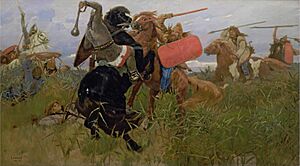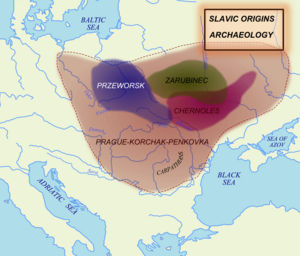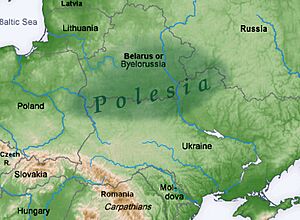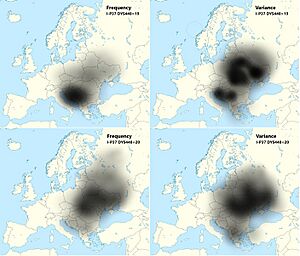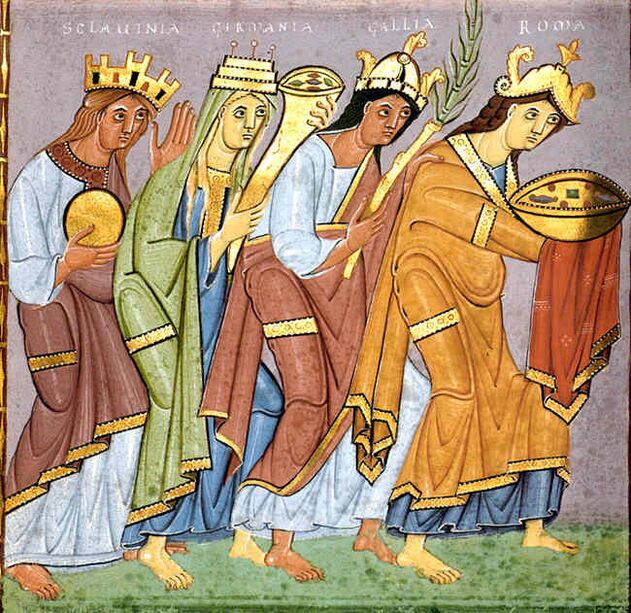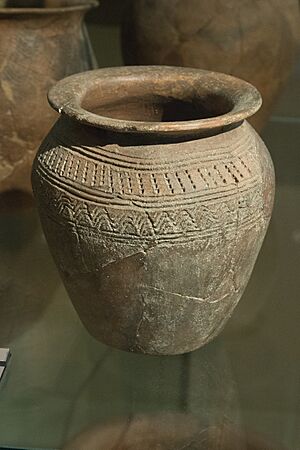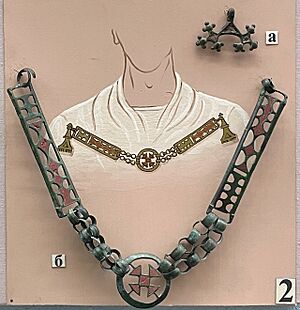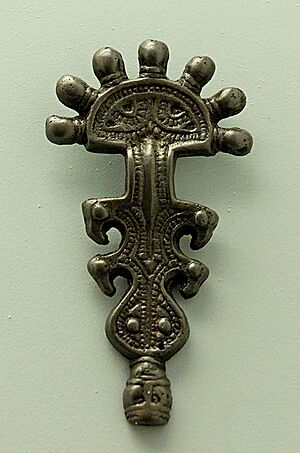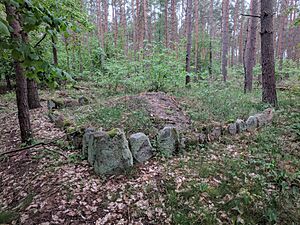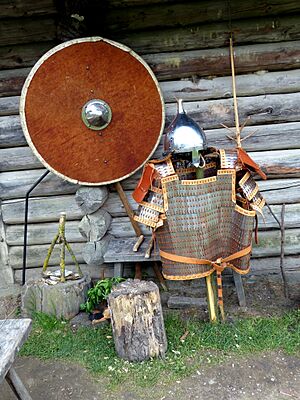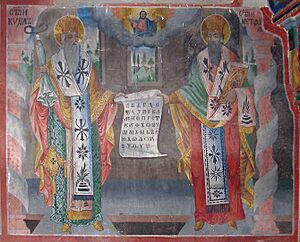Early Slavs facts for kids
The early Slavs were a group of people who spoke Indo-European languages. They lived in Central, Eastern, and Southeast Europe from about the 5th to the 10th centuries AD. These early Slavs helped create the foundations for the Slavic nations we know today.
Historians are still debating exactly where the Slavs first came from. However, most experts agree it was in Eastern Europe, with a region called Polesia being the most likely spot. Ancient Roman writers probably called the ancestors of the Slavs "Venedi." The word "Slav" itself might come from Slavic words for "speech" or "word." This suggests early Slavs used it to describe people who spoke languages similar to their own.
The name "Slavs" first appeared in writing around the 6th century. By then, Slavic tribes lived in a large part of Central and Eastern Europe. Over the next 200 years, they spread widely. They moved west towards the Elbe river and into the Alps. They also went south into the Balkans, and east towards the Volga River. By the 6th and 7th centuries, Slavs controlled or lived in large areas of Europe.
Starting in the 7th century, the Slavs slowly began to adopt Christianity. By the 12th century, they formed the main populations of several medieval Christian states. These included Kievan Rus' (for East Slavs), the Bulgarian Empire and Serbia (for South Slavs), and Great Moravia and the Kingdom of Poland (for West Slavs). The oldest known Slavic state was Carantania, founded in the 7th century.
Contents
Who Were the Early Slavs?
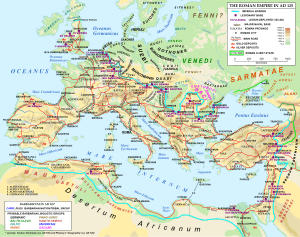
Roman writers from the 1st and 2nd centuries AD knew the early Slavs as the "Veneti." Writers like Pliny the Elder and Tacitus said the Veneti lived east of the Vistula river. Later, during a time of big migrations, the early Slavs split into three groups. Byzantine writers called them Veneti, Antes, and Sclaveni.
A historian named Jordanes wrote in 551 that these three groups came from "one nation." Another historian, Procopius, said the Sclaveni and Antes used to be called "Sporoi." The name "Slověne" might even appear in Ptolemy's Geography from the 2nd century. This could refer to early Slavic tribes allied with the Alanians. Later, in the 8th century, Slavs near the Carolingian Empire were called "Wends."
Archaeologists have found early Slavic artifacts linked to the Zarubintsy, Chernyakhov, and Przeworsk cultures. These date from about 3rd century BC to 5th century AD. However, it's sometimes hard to tell Slavic findings apart from those of other groups like Iranian or Germanic peoples. Later Slavic cultures, from the 6th century onwards, include the Prague-Korchak and Penkovka cultures. These show evidence of fortified settlements, pottery, weapons, and jewelry.
Where Did the Slavs Come From?
The original homeland of the Slavs is called the Proto-Slavic Urheimat. It's the area where Slavs first settled in Central and Eastern Europe. Most experts believe this homeland was in Polesia.
Historical records suggest the Slavic homeland was in Central-Eastern Europe. The Prague-Penkova-Kolochin cultures from the 6th and 7th centuries AD show how Slavic speakers expanded. Key areas for their origin are modern Belarus, Poland, and Ukraine. Some theories suggest earlier cultures like the Trzciniec culture or Milograd culture as the starting point.
How Did Slavic Languages Develop?
Proto-Slavic is the ancient language from which all modern Slavic languages grew. It came from Proto-Indo-European, a very old language that many languages in Europe and Asia came from. Slavic languages share some features with Baltic languages. This suggests they might have had a common ancestor language called Proto-Balto-Slavic.
Proto-Slavic became a separate language around the 2nd millennium BC. Its words described the daily life, feelings, and needs of its speakers. For example, it had words for family members like "husband's mother." The language didn't have many detailed words for things like the sea or mountains. This suggests the early Slavs lived in flat, inland areas.
Old Slavic river names are found between the Vistula and Dnieper rivers. This area borders regions with Baltic and Iranian river names. Early Slavic also borrowed words from Iranian languages, like those spoken by the Scythians and Sarmatians. Words like "god" (*bogъ) and "dog" (*sobaka) came from Iranian languages.
Slavic also borrowed words from Germanic languages. For example, words for "to buy" and "helmet" came from Germanic. This connection helped experts guess where the Slavic homeland might have been.
Slavic History and Expansion
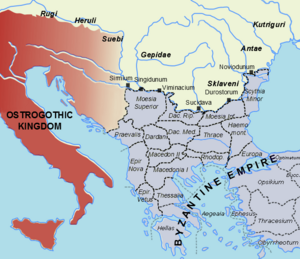
Historians like Jordanes and Procopius wrote about the Slavs in the 6th century AD. Jordanes said the Venethi, Sclavenes, and Antes were all the same group. Procopius described their beliefs, customs, and homes. He also noted that the Sclavenes and Antes spoke the same language.
Another military book, the Strategikon of Maurice, written around 592–602, also described the Slavs. It advised Roman generals to prevent the Sclaveni from uniting under one ruler. It said the Slavs were independent and refused to be enslaved.
Western writers also mentioned the Slavs. They often called them "Veneti" or "Wenden." For example, the Franks called Slavs in the Elbe-Saale region "Wenden." The Chronicle of Fredegar mentioned "Venedi" who formed a state after revolting against the Avars around 623.
Archaeological findings help us understand the spread of Slavs. The Kiev culture (2nd to 5th centuries) is seen as a predecessor to later Slavic cultures. The Prague-Korchak, Prague-Penkovka, and Kolochin cultures (6th and 7th centuries) show the expansion of Slavs from the Dniester to the Elbe.
How Did the Slavs Spread?
Experts have different ideas about how the Slavs spread so widely.
- Culture-Historical View: This idea suggests that the Slavs, living in forests and wetlands, kept their unique identity and language. After the Hunnic Empire fell, the Slavs rapidly spread across Central and Southeastern Europe. They brought their customs and language with them. This was helped by the fact that many Germanic people had left these areas, and the Roman Empire's defenses were weak. Diseases like the Plague of Justinian also reduced populations, making it easier for Slavs to settle.
- Processual View: This idea suggests that the Slavic expansion was mainly about their language spreading. Slavic languages became popular for different reasons. In Central Europe, Slavs migrated and settled. In Eastern Europe, East Slavic became a respected language, replacing older languages. In the Balkans, South Slavic languages spread as new Slavic tribes formed networks. Some historians believe Slavic became a common language (lingua franca) in the Avar Khaganate. Another idea is that the fall of the Hun and Roman Empires created a power vacuum. This allowed a smaller group, the Slavs, to spread their customs and language.
Some experts, like Michel Kazanski, believe it was a mix of both. He thinks that Slavic people moved, but also that their culture spread to non-Slavic groups.
What Do Genetics Tell Us?
Recent studies of DNA help us understand the origin of Slavs. The spread of certain Y-DNA groups (like R1a and I2) matches the early medieval Slavic migrations. This suggests the Slavs spread from Eastern Europe, likely from modern Ukraine and Southeastern Poland.
A 2010 study found that the spread of Slavic culture involved real population movements. If it was just cultural exchange, there wouldn't be as much mixing between Slavic and Germanic peoples. A 2013 study found many common ancestors between South Slavs and Poles. This suggests a "relatively small population that expanded over a large geographic area."
More recent studies in 2022 and 2023 confirmed that medieval Slavic migrations greatly changed the region. They showed that more than half of the ancestry of most people in the Balkans today comes from Slavic migrations. This includes people in countries like Greece, where Slavic languages are not spoken today.
How Did Early Slavs Look?
Writers from the past described the early Slavs. Helmold wrote that the Wends had "blue eyes, ruddy faces, and long hair." Ibrahim ibn Yaqub mentioned that Slavs were bearded. Procopius said Slavs were "tall and especially strong." He described their skin as "not very white" and their hair as "neither blond nor black, but all have reddish hair."
Jordanes also wrote that they were "tall and very strong." He said their skin and hair were "neither very dark nor light, but are ruddy of face." Ibrahim Ibn Ya'qub noted they wore "ample robes." Procopius added that men wore a type of breeches pulled up to the waist.
Other descriptions include Theophylact Simocatta saying the Emperor was "amazed by their height and mighty stature." Hisham ibn al-Kalbi described them as "fair-haired and of ruddy complexion."
Slavic Society and Culture
Early Slavic society was made up of many local groups, or chiefdoms. These groups slowly became more organized between the 7th and 9th centuries. Slavic groups were influenced by their neighbors, like the Byzantines and Vikings.
Procopius wrote that the Slavs "are not ruled by one man, but they have lived from of old under a democracy." This means decisions were made by the people. Over time, some chiefs became more powerful. They were supported by warriors. As chiefdoms grew, they sometimes became early medieval states. By the mid-9th century, Slavic leaders were quite sophisticated. They wore fancy clothes and hunted with falcons.
Tribes and Territories
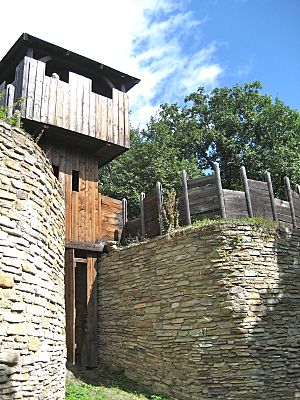
Before AD 560, there's no mention of single Slavic chiefs. The Slavs lived by their own rules. The Strategikon of Maurice said the Slavs were independent and refused to be ruled.
Slavic settlements were often grouped together, with empty spaces between them. These groups grew from single settlements and were linked by family or clan ties. The smallest territorial unit was called a župa or opole. Several župas formed tribes.
Many tribal names came from the land they lived in. For example, the Moravians lived along the Morava river. Other names, like the Polanes, meant "field dwellers." Some names, like Antes and Croats, might have come from non-Slavic languages.
Settlements and Homes

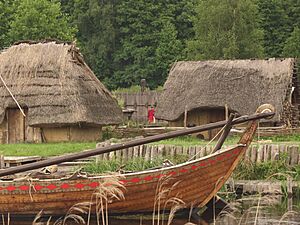
Early Slavic settlements were small, usually less than 2 hectares (5 acres). They were often temporary and located along rivers. Their homes were usually sunken buildings, called Grubenhäuser or poluzemlianki. These were built over a rectangular pit, about 4 to 20 square meters in size. Each house had a stone or clay oven in a corner. A settlement might have 50 to 70 people.
Slavs also built underground shelters with wooden roofs to stay warm in winter. They used log cabin saunas, as described by Ibrahim Ibn Ya'qub. He wrote about how they would heat stones, pour water on them for steam, and then use grass to make air circulate.
Fortified strongholds, called gords, became common in the 9th century, especially in Western Slavic areas. The Slavs preferred to live in hard-to-reach places to avoid attacks. Maurice's Strategikon noted they lived among "nearly impenetrable forests, rivers, lakes, and marshes."
Food and Farming
The Slavs hunted, farmed, raised animals, and kept bees. They often settled in fertile valley bottoms near rivers. They knew about crop rotation and developed a new type of plow called the moldboard plow. This plow was very good at breaking up heavy clay soil. It helped their population grow a lot. They also used iron hoes, sickles, and wooden spades.
They grew cereal crops like wheat, millet, and barley. Vegetables included onions, carrots, radishes, and cabbage. They also grew fruits like cherries, apples, and plums in orchards.
They raised cattle for meat, milk, and to pull plows. Pigs were also important for meat. They kept goats, sheep, ducks, and geese. Horses were mostly used for riding or pulling things, not usually for food.
In the forests, they hunted boar, deer, and elk. They trapped beavers and martens for their fur. Ibrahim Ibn Ya'qub wrote that they ate beef and goose, and made drinks from honey. Ibn Rusta mentioned they collected a lot of honey from beehives and drank mead.
Craftsmanship
Early Slavs were skilled at working with wood, leather, metal, and clay. Pottery was made by hand, sometimes with a pottery wheel. Clay was mixed with sand or crushed rock, then dried and baked.
Metalworking was very important for tools and weapons. Smiths used local iron ore to make knives, tools, and decorative items. Iron was valuable, so broken tools were often melted down and remade.
Houses and many everyday items were made from wood. Carved bowls and dippers were common. They also made textiles from linen and wool for carpets, blankets, and clothes. Glass beads were crafted and used for trade.
Clothing and Music
We learn about Early Slavic clothing from old pictures and burial sites. Clothing varied by region, season, and social status.
Men wore long-sleeved tunics made of linen or wool, reaching to their knees. They wore breeches underneath. Wool cloaks were sometimes worn over tunics, fastened at the shoulder. Some cloaks were made of leather and lined with fur. Hats and mittens were worn in winter. Both men and women wore leather boots. Men often had a belt with a knife.
Women wore long patterned dresses, sometimes with an apron. Unmarried women wore their hair braided or loose, but married women covered their hair. They also wore ornaments and jewelry like beads and bracelets.
The Slavs had many musical instruments. Ibn Rusta mentioned "different kinds of lutes, pan pipes and flutes." He said their lutes had eight strings. Theophylact Simocatta mentioned Slavs carrying lyres.
Burial Practices
The Slavs burned their dead. This was seen as a way to free the soul from the body. Ibn Rusta described how after burning a body, they collected the ashes in an urn and buried it on a hill. After a year, the family would gather there to eat and drink.
Laws and Warfare
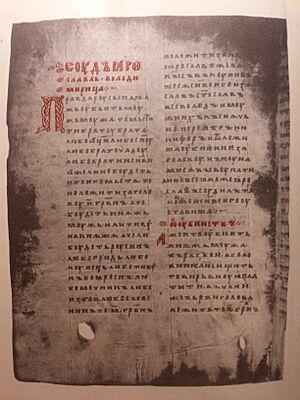
Early Slavs didn't have written laws. They followed customs that told them what was right and wrong. One important custom was hospitality. If a tribe treated a guest badly, a neighboring tribe might attack them for dishonoring the custom. Written laws for East Slavs didn't appear until the rule of Yaroslav the Wise.
Ibn Rusta wrote about Slavic law around 903–918. He said the ruler collected taxes each year. Thieves were sentenced to death or sent away to a distant region.
Our knowledge of Early Slavic warfare comes from old writings and archaeological finds. Early Slavic warrior groups were usually small, around 200 people. They aimed for quick attacks and retreats. They preferred ambushes and guerrilla tactics, fighting in dense forests or marshes. However, they also won battles in open areas and used siege engines like towers and ladders.
Their main weapons were spears, javelins, bows, and arrows. Swords and body armor were rare, usually only for chiefs. Shields were round. Axes and slings were also used.
While they mostly fought on foot, Slavs were also skilled horsemen. Procopius mentioned Slavic horsemen serving as mercenaries. This skill might have helped their expansion. A Slavic chief named Dobret famously refused to accept the rule of the Avars, saying, "Others do not conquer our land, we conquer theirs."
Writing and Symbols

Whether Early Slavs had writing is debated. They passed down stories orally. However, a 9th-century Bulgarian writer mentioned that before Christianity, Slavs used "strokes and incisions" for counting and divination.
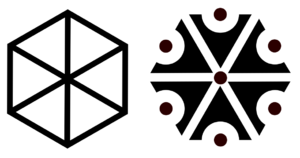
The Slavs had many symbols representing their beliefs and gods. The Kolovrat, meaning "spinning wheel," symbolized the sun and the cycle of life. It was often carved near graves to represent eternal life.
Gromoviti Znaci were symbols linked to Perun, the Slavic thunder god. These circular symbols, representing ball lightning, were carved on house beams to protect from lightning. Another symbol for Perun was the Perunika, a six-petalled rose. The "hands of God" was an ancient symbol linked to the god Svarog.
Slavic Religion
We don't know much about Slavic religion before they became Christian. After Christianization, many records of the old religion were destroyed. What we know comes from a few texts, word origins, and the Primary Chronicle.
Ancestor worship was a key part of their pre-Christian religion. Early Slavic religion was generally uniform. It was animistic, meaning they believed spirits lived in natural objects like springs, trees, or stones. They respected these spirits. It was also polytheistic, meaning they believed in many gods. Over time, the idea of a "supreme god" ruling over others developed.
Slavic paganism mixed with other religions. Linguistic evidence shows it shared elements with Baltic religions. Later, they interacted with Iranian peoples and added parts of Iranian spirituality. Both Slavs and Iranians had demons with similar names and believed in a struggle between good and evil.
Pre-Christian Slavic spirits and demons could be independent beings or spirits of the dead. They were linked to homes or nature. Forest spirits were respected, as were home spirits, often related to ancestors. Spirits could be good or evil. Slavs honored them with sacrifices and gifts. Famous spirits include Leshy (forest spirit), Domovoy (home spirit), Rusalka (water spirit), and Baba Yaga.
Evidence of pre-Christian Slavic worship is rare. They mostly worshipped outdoors, often on hills with circular ditches. Indoor shrines were rare but did exist. One was found in Kiev, surrounded by animal bones.
Records of Slavic priests also appeared later. After Christianization, many sorcerers and magicians were still present. This suggests pre-Christian Slavs had religious leaders. These pagan priests, called volkhvy by the Rus' people, were believed to talk to gods and predict the future. They resisted Christianity.
Later Slavic History
Becoming Christian
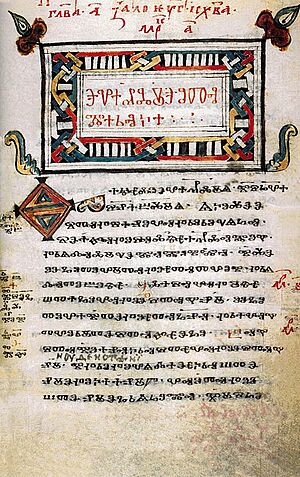
The process of Slavs becoming Christian started in the 7th century and finished in the 12th century. The Christianization of Bulgaria became official in 864. Bulgaria's important location meant both the Greek East (Orthodox) and the Latin West (Catholic) wanted them to join their side. Bulgaria eventually sided with Constantinople and got its own national church in 870. This was the first for the Slavs.
The First Bulgarian Empire became a major cultural and literary center for Slavic Europe. The Cyrillic script was developed there and became official in Bulgaria in 893. Old Church Slavonic also became the official language for church services.
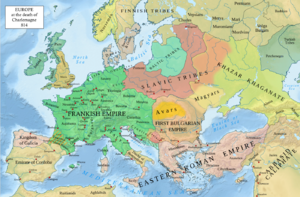
While some East Slavs became Christian early, Kievan Rus' mostly remained pagan until Vladimir the Great was baptized in the 980s. The Christianization of Poland began in 966 with King Mieszko I's baptism. Slavic paganism lasted longest in Pomerania, until the Wendish Crusade in 1147. The last stronghold of paganism was a temple to the god Svetovid on Cape Arkona, which was taken in 1168.
Medieval Slavic States
After becoming Christian, the Slavs formed many kingdoms and principalities. The First Bulgarian Empire was founded in 681. It was an alliance between the ruling Bulgars and the many Slavs in the area. The Bulgars, a smaller group, became the ruling class.
The South Slavs also established the Duchy of Croatia in the early 7th-8th centuries, which became the Kingdom of Croatia in 925. The Principality of Serbia also emerged. The Banate of Bosnia developed later, merging smaller local areas.
In the west, the Slavs formed Samo's Empire, the first Slavic state in that region. Then came Great Moravia, followed by the Kingdom of Poland, the Obotritic confederation, and the Duchy of Bohemia (modern Czech Republic).
After the death of Yaroslav the Wise in 1054, Kievan Rus' broke into many smaller principalities. From these, Muscovy became the most powerful after 1300. The western parts of Kievan Rus' were later taken over by the Grand Duchy of Lithuania.
|


